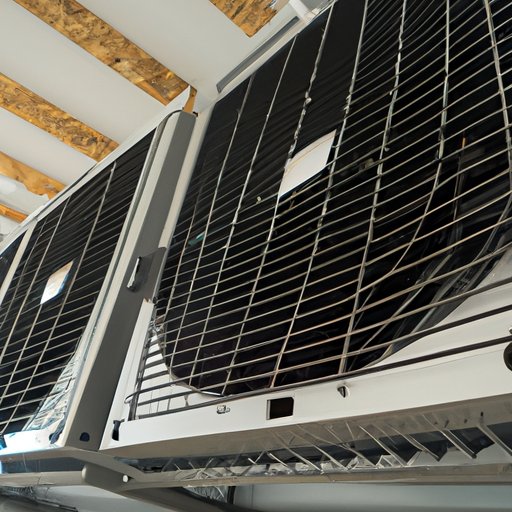Introduction
Are you looking to cool your home efficiently and effectively? One crucial factor to consider is the number of British Thermal Units (BTUs) needed to provide optimal comfort. Understanding how many BTUs in a ton is critical to ensuring your home stays comfortable year-round. In this comprehensive guide, we’ll explain how BTUs and tons relate to each other, why calculating the correct number of BTUs for your home is essential, and how to convert tons to BTUs correctly.
Understanding BTUs in a Ton: A Comprehensive Guide
Beyond just being a measure of energy, BTUs are the amount of heat required to raise the temperature of one pound of water by one degree Fahrenheit. In the context of cooling, it refers to the amount of heat energy that needs to be removed from a space, and it’s often used to describe the cooling capacity of air conditioning systems.
A ton of cooling refers to removing the heat equivalent to melting one ton of ice per day at 32 degrees Fahrenheit. This measurement is used to describe the size of an air conditioning system. The higher the tonnage, the larger the AC unit needed to keep your home cool and comfortable.
The relationship between BTUs and tons is straightforward: one ton equals 12,000 BTUs. Depending on factors such as your home’s size, insulation, and the climate in your area, your HVAC system may require more or fewer BTUs to achieve your desired cooling capacity.
How Many BTUs in a Ton: Calculating for Optimal Home Comfort
Calculating the correct number of BTUs needed is essential to achieve optimal home comfort efficiently. The number of BTUs to cool a home depends on factors such as the home’s square footage, insulation, climate, ceiling height, number of windows, and several other factors.
To calculate how many BTUs your home needs, you can use an online BTU calculator, or you can use the following rule of thumb: every square foot of your home requires 20-25 BTUs of cooling power in moderate climates. In hot climates, this may increase up to 30 BTUs.
Common mistakes when calculating BTUs include not factoring in ceilings height and windows’ types, sizes, and locations. The result may be an air conditioning unit that’s too small (which will wear out quickly, increase energy use and leave you with an uncomfortably warm home) or too large (which will drive up energy costs because the unit will cycle on and off more frequently than needed).
Converting Tons to BTUs: A Quick and Easy Explanation
Converting tons to BTUs is an essential skill to understand. A simple way to convert tons to BTUs that’s widely used is to multiply the tons by 12,000. For example, if you have a two-ton air conditioner, you would multiply 2 by 12,000 to get 24,000 BTUs.
Knowing how to convert tons to BTUs is beneficial when comparing different air conditioning models or providing details to your HVAC contractor.
Why Knowing How Many BTUs in a Ton is Important for Your HVAC System
Incorrectly sizing your HVAC system can lead to a range of problems, some of which can be quite severe. If your system is too small, it will struggle to keep up with demand, and over time, it will wear out more quickly. Your home’s air quality will suffer, and you’ll be at risk of higher energy bills. If your system is too large, it will cycle on and off too frequently, which will also increase energy bills and reduce the air conditioner’s lifespan.
By correctly sizing your HVAC system and ensuring it has the right number of BTUs, you can save money, improve your indoor air quality and make your home more comfortable. Troubleshooting an underperforming HVAC system can be a stressful and expensive process, but it’s almost always preventable by getting the right number of BTUs.
The Relationship Between Tons and BTUs: Everything You Need to Know
By now, you should have a good understanding of how many BTUs in a ton, how they relate to each other, and how to calculate the correct number of BTUs for your home. Knowing how many BTUs in a ton and why it’s essential to have the appropriate number for your HVAC system is crucial for any homeowner.
Before you go, here are our top recommendations for maintaining the optimal number of BTUs in your home:
- Use an online calculator or consult with an HVAC contractor to determine your home’s square footage and insulation level accurately.
- Consider climate factors and the location of your home’s windows before making any decisions about BTUs.
- Always ensure your HVAC system has the correct number of BTUs; a small increase in price now could save you thousands over the lifetime of your system.
Conclusion
Understanding how many BTUs in a ton is essential for keeping your home cool, comfortable, and energy-efficient. By taking into account critical factors such as your home’s square footage, insulation levels, and climate, you can calculate the correct number of BTUs needed for your HVAC system. And by doing so, you can save money, improve your indoor air quality, and make your home a comfortable place to be all year round. Take the time to get it right the first time, and enjoy a cool, comfortable, and energy-efficient home for years to come.
